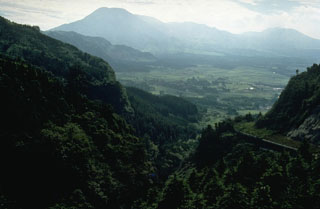Report on Asosan (Japan) — 18 February-24 February 2015
Smithsonian Institution / US Geological Survey
Weekly Volcanic Activity Report, 18 February-24 February 2015
Managing Editor: Sally Sennert.
Please cite this report as:
Global Volcanism Program, 2015. Report on Asosan (Japan) (Sennert, S, ed.). Weekly Volcanic Activity Report, 18 February-24 February 2015. Smithsonian Institution and US Geological Survey.
Asosan
Japan
32.8849°N, 131.085°E; summit elev. 1592 m
All times are local (unless otherwise noted)
JMA reported that, based on seismicity and infrasound data, the eruption from Asosan’s Nakadake Crater that began on 25 November 2014 continued during 16-20 February. Plumes rose 900 m above the crater and high-amplitude tremor continued to be detected. The Alert Level remained at 2 (on a scale of 1-5).
Geological Summary. The 24-km-wide Asosan caldera was formed during four major explosive eruptions from 300,000 to 90,000 years ago. These produced voluminous pyroclastic flows that covered much of Kyushu. The last of these, the Aso-4 eruption, produced more than 600 km3 of airfall tephra and pyroclastic-flow deposits. A group of 17 central cones was constructed in the middle of the caldera, one of which, Nakadake, is one of Japan's most active volcanoes. It was the location of Japan's first documented historical eruption in 553 CE. The Nakadake complex has remained active throughout the Holocene. Several other cones have been active during the Holocene, including the Kometsuka scoria cone as recently as about 210 CE. Historical eruptions have largely consisted of basaltic to basaltic andesite ash emission with periodic strombolian and phreatomagmatic activity. The summit crater of Nakadake is accessible by toll road and cable car, and is one of Kyushu's most popular tourist destinations.

